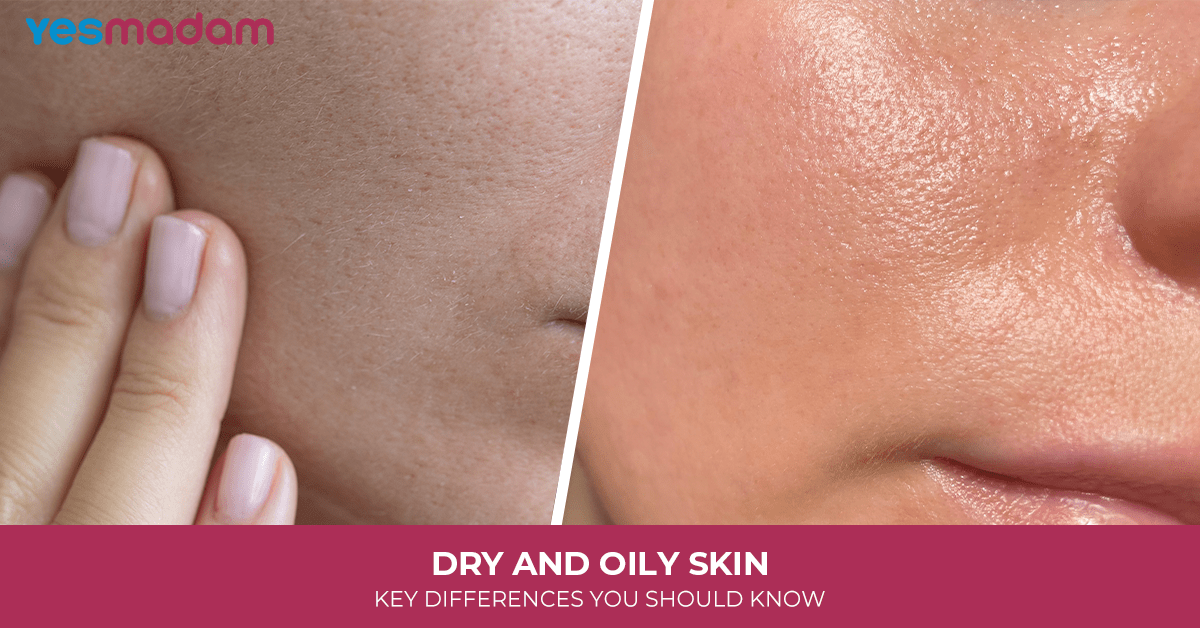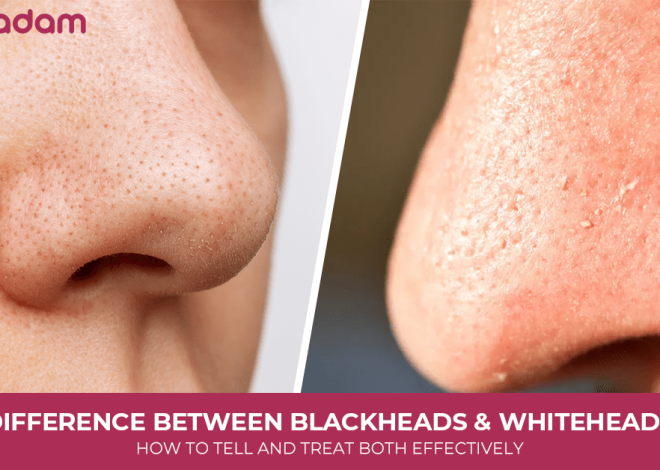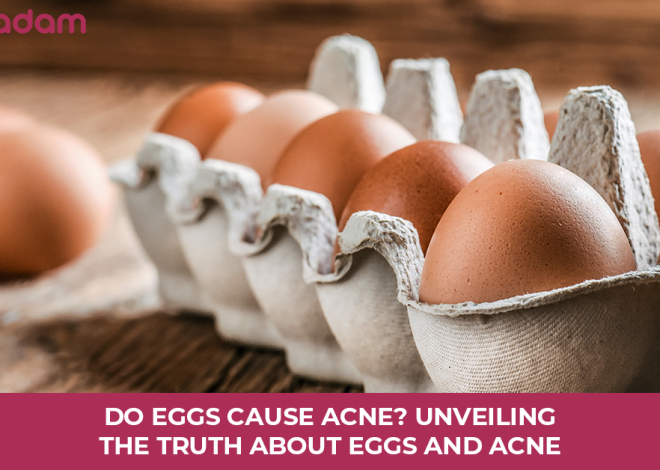
Dry and Oily Skin: Key Differences You Should Know
Dry oily skin, a unique skin condition, is a paradox -oily in some areas and dry in others. It conveys the fact that skincare is a balancing act.
This blog on dry and oily skin will help explore the causes behind dry, oily skin, combined with the differences, tips to find out if you have oily or dry skin, and practical skincare tips to manage both effectively.
Table of Contents
Dry Skin And Oily Skin: 5 Common Causes Explained

Understanding the causes of dry and oily skin, as stated below, will help address the core concerns, like how to find dry or oily skin, the ultimate skincare routine to take care of both, and more.
- Barrier disruption: Excess use of chemicals and alcohol-containing products may disrupt the skin’s natural barrier, causing dryness in some zones, while stimulating oil production in others.
- Combination skin. It includes a mix of dry and oily areas, usually oily in the T-zone (chin, forehead, nose) and dryness on the cheeks.
- Hormonal dysfunction and skin health. Hormonal fluctuations during puberty, menstrual cycles, or menopause often lead to increased oil production along with dry patches.
- Puberty: A time for skin evolution. Puberty often triggers hormonal fluctuations, resulting in increased sebum production or oily skin. These same changes may also cause dryness in some areas.
- Fungal infections. Fungal infections like tinea faciei may lead to scaly patches that often appear dry, but are usually accompanied by an oily surface.
Difference Between Oily and Dry Skin
The oily skin and dry skin difference lies in the fact that oily skin appears shiny and greasy with large pores, prone to breakouts, while dry skin feels tight, rough, and flaky, appearing dull and lackluster.
Oily Skin
- Appearance: Often looks shiny, especially in the T-zone (forehead, nose, and chin).
- Texture: May feel greasy by midday.
- Pores: You’ll likely notice enlarged or dilated pores.
- Concerns: Prone to blackheads, whiteheads, and other forms of acne due to excessive sebum.
- Cause: Overactive sebaceous glands producing too much sebum.
Dry Skin
- Appearance: Can look dull, rough, or flaky.
- Texture: Feels tight, especially after cleansing, and may have rough patches or a scaly appearance.
- Pores: Pores are often small and not visible.
- Concerns: Can become itchy and may show fine lines more easily.
- Cause: A lack of adequate moisture and sebum production by the sebaceous glands.
How to Determine Your Skin Type
A simple at-home test can help:
- Cleanse: Wash your face with a gentle cleanser and pat it dry.
- Wait: Do not apply any toner or moisturizer.
- Observe: After 30 minutes to an hour, look at your skin:
- Oily Skin: Your entire face, especially your forehead and nose, will appear shiny.
- Dry Skin: Your skin will feel tight, rough, or flaky.
Don’t Miss: Does Peanut Butter Cause Acne
How to Know If My Skin Is Oily or Dry: Key Facts and Tips

While a simple at-home test can help determine your skin type, here are additional facts and tips that will help you to conclude how to know if your skin is oily or dry.
1. Dry Skin vs Oily Skin: As Per Your Pores
- For dry skin: If you have dry skin, your pores may look small and tight.
- For oily skin: In case of oily skin, your pores are easily visible and get clogged by the oil and sweat that the body produces.
2. Dry Skin vs Oily Skin: Simple Blotting Paper Test
- Press a clean tissue gently onto different zones of your face.
- If the tissue traps noticeable oil from all over your face, this indicates that you have oily skin.
- If your skin remains dry throughout the test, you probably have dry skin.
- If the tissue shows some oil from your forehead and nose, but remains dry on the cheeks, you likely have combination skin or a mix of both dry skin oily skin.
More Information For You: Cucumber Benefits For Skin
Ultimate Skincare Routine for Dry Skin and Oily Skin: A Step-by-Step Guide
Okay! Now that you have figured out how to tell if you have dry or oily skin, it’s time to explore the detailed skincare guide on how to take care of both.
A Step-by-Step Guide on Ultimate Skincare Routine for Oily Skin

Here’s a detailed step-by-step routine for oily skin :
Step 1: Cleanse using a gentle, oil-control face wash
Choosing a gentle yet strong cleanser is essential for oily skin to remove excess dirt, cosmetics, and sebum while maintaining the skin’s natural moisture balance.
Pro tip: Cleanse face two times a day, each morning and night. This two-time ritual helps keep the skin balanced and clean.
Step 2: Toner to balance the skin
Toners are often neglected, but are important for oily skin. They help balance skin PH and minimize the look of large pores.
Pro tip: For oily skin, select a toner without alcohol. It should include tea tree oil, salicylic acid or witch hazel.
Step 3: Serum to brighten and protect
Apply a serum for oily skin after toning. Here are the must-have ingredients to even and brighten your complexion:
- Vitamin C: Fades sun spots and dark patches. Good for acne survivors.
- Alpha arbutin: Minimizes dark spots and evens your skin tone. Makes skin smooth.
- Blueberry extract: Strengthens the skin’s barrier and prevents ageing.
Step 4: Hydrate using a lightweight moisturiser
Hydration is important for oily skin, too. If you skip moisturiser, it may make your skin produce more oil as a way of compensating for the lack of moisture.
For oily skin, choose a lightweight non-comedogenic moisturiser that includes:
- Squalene leaves the skin supple and soft without added oiliness.
- Niacinamide minimizes large pores and controls sebum production.
- Vitamin C protects against stressors and brightens skin tone.
Step 5: A targeted serum to treat and prevent blemishes
A targeted serum is great for oily skin. A good targeted serum should contain the blend of:
- Gold leaf particles to brighten your complexion and provide you with a healthy glow.
- Niacinamide helps minimize pore size and controls oil, making it suitable for oily skin.
- Mulberry extract brightens your skin, protects it from damage, and fades dark spots.
- Hyaluronic acid, as a top hydrator, leaves your skin plump and smooth.
Step 6: Sun protection is a must
Sunscreen is necessary even for those with oily skin. Select a broad-spectrum sunscreen with SPF 30 or higher, made for oily skin.
Pro tip: A mattifying sunscreen can help control shine. It will keep your oily skin fresh all day.
Step 7: Exfoliate regularly (But don’t over-exfoliate)
Exfoliation is crucial for oily skin. It eliminates dead cells and unclogs pores. Still, you should not overdo it. Too much exfoliation can dry out your skin and give a boost to oil production.
Step 8: Treat skin with a weekly clay mask
Clay masks are good for oily skin. They eliminate excess oil, dirt, and impurities, thereby cleansing the skin. Choose masks containing bentonite clay and kaolin, as they are both effective and gentle.
Pro tip: You can apply a clay mask one to two times a week, as per your skin’s oiliness. Don’t forget to follow up with a hydrating serum or moisturiser.
A Step-by-Step Guide on Ultimate Skincare Routine for Dry Skin

Here’s a five-step-by-step skincare routine for dry skin :
1. Cleanse to eliminate impurities
For dry skin, a cream cleanser is the best choice. The nourishing formula in cream cleansers eliminates oil, makeup, and dirt and exfoliates gently to smooth and soft-feeling skin.
2. Apply a hydrating serum
Skincare for dry skin and hydration always go in tandem. For this, both daytime and nighttime face serums do the needful. A hydrating facial day serum instantly replenishes hydration. A nighttime face serum often infused with hyaluronic acid helps give a boost to the skin’s overnight repair processes.
3. Apply eye cream or serum
It’s not just your forehead, cheeks, and chin that require locking in moisture. Areas around your eyes also need a little extra moisture, even if you have dry skin. This is where the idea of applying eye cream or serum comes in.
4. Moisturize your face and neck
As dry skin lacks adequate moisture, applying moisturising formulas will help hydrate and add moisture back into the skin without leaving your skin feeling slick or greasy.
5. Finish with SPF
A skincare routine for dry skin is incomplete without sunscreen. Apply a non-greasy, broad-spectrum sunscreen formula with an SPF of at least 30 to protect against UVA and UVB rays, leaving your skin feeling moisturised and fresh.
Oily Skin Vs Dry Skin: Skincare Tips To Ace The Dry Skin Oily Skin Comparison Game
After having a fair idea about how to tell dry skin and oily skin difference and care for each type, let’s unlock the practical skincare tips that work for both skin types.
Skincare Tips for Dry Skin
- Wash face with lukewarm water: As hot water can strip your skin of essential oils, causing or rather exacerbating dryness and discomfort.
- Apply moisturiser to damp skin: Whether you have just hopped out of the shower or have finished cleansing your face, apply moisturiser without reaching for a towel immediately. It boosts hydration, improving the feelings of tightness and dryness.
- Apply sunscreen even on cloudy, grey days: UV rays are always present, and exposure may further damage dry skin.
- Protective clothing: Cover as much skin as possible during cold, windy weather. Wear full-sleeved clothes while stepping out during summer.
- Stay hydrated: Drink a lot of water and non-caffeinated beverages to keep your skin moisturised from the inside.
Skincare Tips for Oily Skin
- Use an oil-free moisturiser: Apply a light-weight, non-comedogenic, lightweight moisturiser at least once a day that will not make your skin oilier and will keep your skin hydrated.
- Blot face: Gently blot your face as required throughout the day to remove excess oil buildup and shine.
- Use water-based makeup: Avoid heavy makeup that can clog pores. Instead, use water-based makeup and apply lightly.
- Try gentle exfoliation and retinoids: Oily skin complexions may benefit from the use of retinoids and gentle exfoliation to help boost skin cell turnover and remove dead cells.
- Avoid touching your face: Do not touch your face throughout the day to prevent bacteria, oil, and dirt from spreading from one area to another.
Conclusion
The difference between dry skin and oily skin is a glaring example to emphasize that every skin type is unique, and what works for one person may not work for another. Therefore, understanding dry vs oily skin types can help you to be comfortable with your skin’s condition, decide which products to use, and what skincare tips to follow.
FAQs
How to know whether our skin is oily or dry?
Wash your face with a gentle cleanser, pat it dry, and then wait 30 minutes to an hour without applying any products. Oily skin will look shiny all over, especially in the T-zone (forehead, nose, and chin). Dry skin will feel tight, rough, or flaky.
Which is better, dry skin or oily skin?
Neither oily nor dry skin is inherently better, as each has unique advantages and disadvantages; instead of looking for the “best” type, the focus should be on understanding your individual skin type and developing an appropriate skincare routine for it.
Why is my face oily, but I have dry skin?
Your face is oily and dry because it is likely combination skin, where your sebaceous glands are overactive in certain areas like the T-zone, but the rest of your skin lacks moisture.
Can skin be dry but oily?
Yes, skin can be both dry and oily, a condition known as combination skin, or it can be dehydrated, where it looks oily but feels dry.
What causes dry skin?
Dry skin can be caused by genetics, harsh weather, over-washing, hot showers, or skincare products that strip away natural oils.
What causes oily skin?
Oily skin is often due to genetics, hormonal changes, stress, or using heavy skincare products that clog pores. Diet and climate can also influence oil production.
Can my skin type change over time?
Yes. Skin type can change with age, weather, hormones, and lifestyle. For example, oily skin can become drier as you age, and dry skin may feel oilier in hot, humid weather.
Is oily skin more prone to acne than dry skin?
Yes. Oily skin produces more sebum, which can clog pores and lead to acne. However, dry skin can also break out if the skin barrier is damaged or if harsh products are used.
What skincare routine is best for dry skin?
For dry skin, use a gentle cleanser, hydrating toner, a nourishing moisturizer with hyaluronic acid or ceramides, and sunscreen. Avoid products with alcohol or sulfates that strip moisture.
What skincare routine is best for oily skin?
For oily skin, use a foaming or gel-based cleanser, a lightweight oil-free moisturizer, products with salicylic acid or niacinamide, and sunscreen. Avoid thick creams and pore-clogging products.



